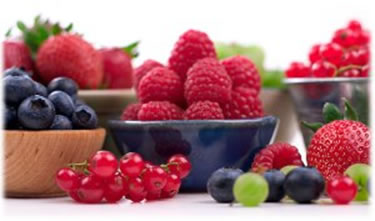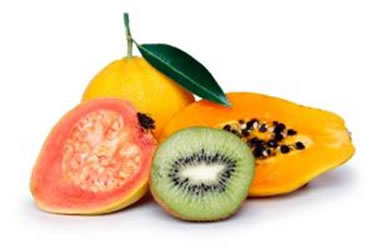We often refer to antioxidants as the miracle substances which help our body to fight diseases and help us live longer. What are they and what is their impact on the body? What kinds of foods contain antioxidants? Mediterranean Diet is a diet which is known to contain in its food pyramid, the Mediterranean Diet pyramid, the right foods which contain the right antioxidants which help our body to stay healthy.
Antioxidants are those substances which have a particular characteristic, a characteristic which makes them able to neutralize the action of free radicals (molecules) generated in the body as a result of oxidation! More specifically, the free radicals are essential to all living organisms, and form a barrier of protection against the invasion of harmful microorganisms and foreign substances in the body. Therefore, they are part of the natural immune system of the body. If for whatever reason the level of free radicals in the body increases they stop being useful to the body and are most dangerous. So it is important to know what kinds of food contain antioxidants so that we will put them on our table and in our life!
What happens when the level of free radicals increases?
When the level of free radicals in the body increases then the DNA of cells and tissues is altered, we have premature skin aging, weakened hair, while at the same time it favours conditions for the onset of atherosclerosis, diabetes, cardiovascular disorders and obesity. In short we can say that free radicals are responsible for tissue damage and aging. So it is important to put antioxidants in your life and so as to acquire a strong ally for your health!
What are antioxidants and in which foods we can find them?
Vitamin E is one of antioxidants we should put in our life and it is found in: Vegetable oils, nuts, liver, eggs, butter, beans, broccoli, avocados, whole grains, and green leafy vegetables. The properties of Vitamin E are: It slows the creation of atherosclerosis and enhances the effectiveness of the immune system of the body.
Vitamin C is yet another important antioxidant and it is found in: citrus fruits such as grapefruit, kiwi, strawberries, peppers, tomatoes, artichokes, cabbage, and parsley. Vitamin C has many properties some of which are: It facilitates the absorption of iron and protects against free radicals associated with the development of cardiovascular, neurological, oncological diseases and premature aging.
Carotenoids are a group of soluble nutrients synthesized by plants which are responsible for the color of various fruits and vegetables. Food sources of carotenoids are fruits and vegetables in yellow-orange vegetables and green foliage. The beneficial properties of carotenoids are: they capture free radicals, protecting cell membranes from oxidation damage and fight aging and skin cells.
Coenzyme Q10 is a substance produced by our body or it is found naturally in foods and is responsible for the basic functioning of the cells. Coenzyme Q10 can be found in: peanuts, liver, whole grains, walnuts and beef. Its beneficial properties are: Protection of the cardiovascular system and other actions similar to vitamin E.
Selenium is a mineral with antioxidant properties which protects the cells from damages. In general it is essential for good health but it is required in small quantities. Selenium is found in foods like: mushrooms, beef offal, butter, wheat grain, garlic, onions, cereals, meat and fish. Selenium prevents hypertension, anaemia, various types of tumours and aging.
Polyphenols are antioxidants found in fruits such as: bright color fruits and vegetables (cabbage, carrots, pumpkin, floral zucchini, spinach, peppers, leeks, endive, lettuce, blueberries, blackberries, cherries, plums, apricots, melons, apples, oranges, black currants, dried vegetables and Beverages derived from vegetable products (tea, wine, beer). Polyphenols play a role in preventing numerous degenerative diseases such as atherosclerosis and cardiovascular diseases. They have anti-inflammatory properties, and anti-allergic and antimicrobial properties which mean they help the body fight viruses.
Flavonoids are antioxidants which fight aging and prevent various diseases. They get their name from the Latin word ‘’flavus’’ which means yellow. Sources of flavonoids are: various forest fruits like blueberries and raspberries, eggs, lemon, grapefruit, plum, red wine. Flavonoids fight inflammation and osteoporosis. They have anticancer properties and help the decrease of blood pressure.

Anthocyanins are associated with flavonoids and protect us against many diseases. They are responsible for the red, purple and blue color of fruits and vegetables. As expected the sources of Anthocyanins are vegetables and fruits with red, blue or purple, such as tomatoes, peppers and eggplants. Some of their properties are: protections of the cardiovascular system and the blood veins. They fight blood circulation problems, weakness of the capillary and prevent atherosclerosis caused by high cholesterol levels.
Tannins are polyphenols which are present in many plant foods. Sources of Tannins are: raisins, red wine, tea, cranberries and pomegranates. Tannins act as antibacterial, antifungal and anti-diarrheal. They activate the circulation and help the regeneration of tissues affected by minor wounds and burns.
Going through all the antioxidants one can easily observe that in all classes the sources of antioxidants were fruits, vegetables, nuts, herbs and wine and all are basic components of the Mediterranean diet, a diet which has been proven over thousands of years.
















{ 0 comments… add one now }